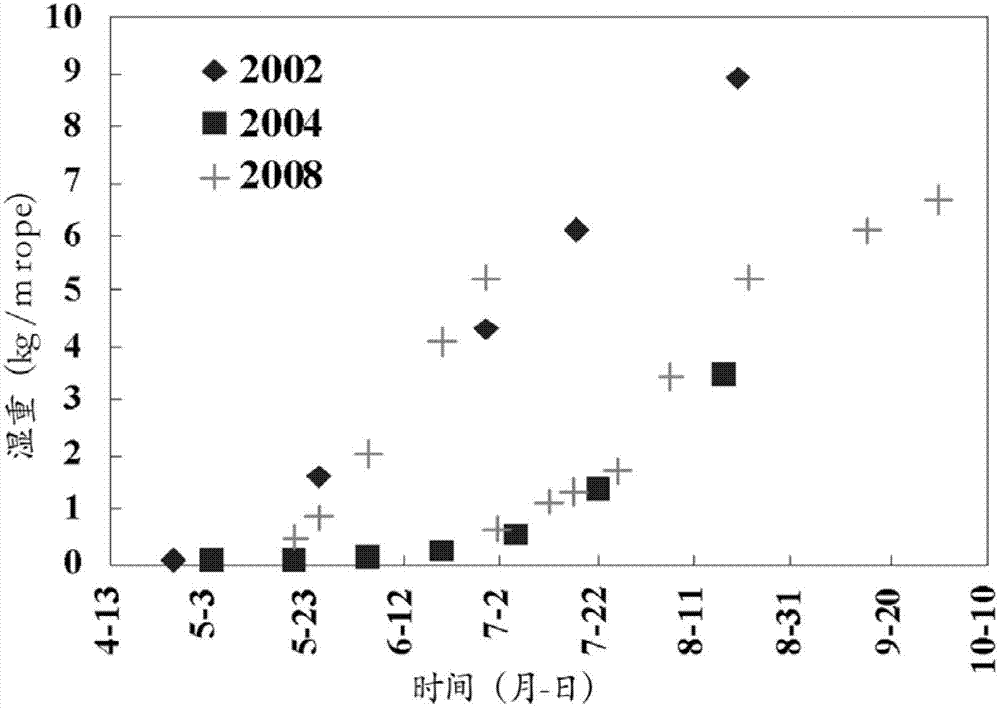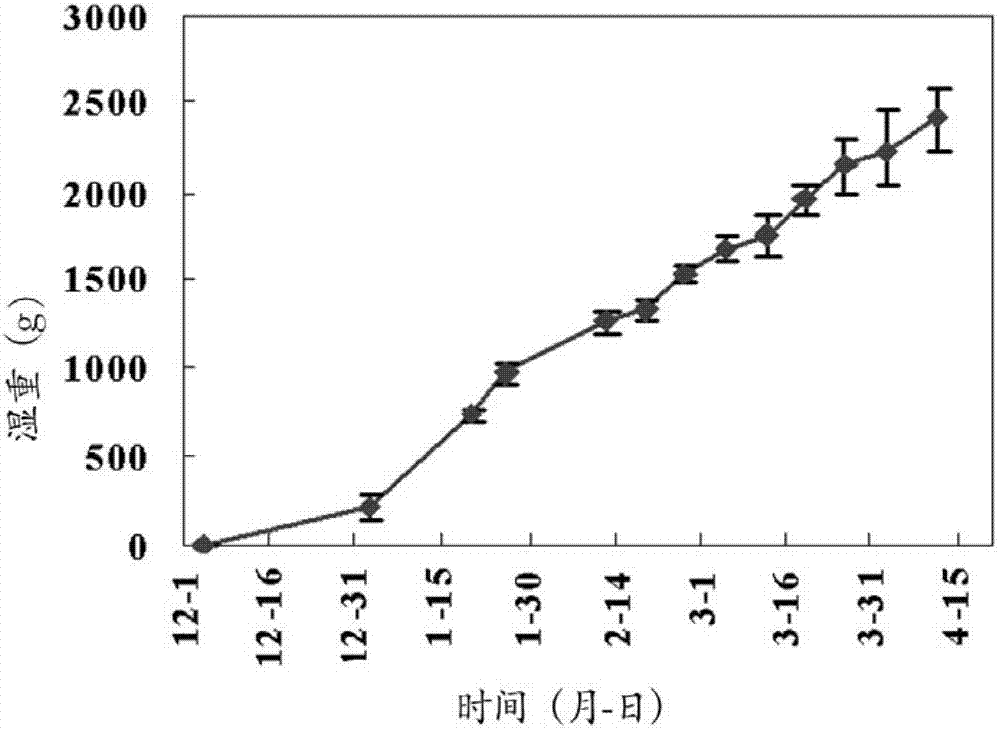Method for cultivating kelp and asparagus alternately
A technology of asparagus and kelp, which is applied in the field of seaweed cultivation, can solve the problems of labor surplus, threat of breeding organisms, waste of human and material resources, etc., and achieve the effects of saving labor costs, improving the sea area environment, and saving production costs
- Summary
- Abstract
- Description
- Claims
- Application Information
AI Technical Summary
Problems solved by technology
Method used
Image
Examples
Embodiment 1
[0052] A method of cultivating kelp and Asparagus in rotation. From November to June of the following year, kelp is cultivated, and from May to November, the specific method is as follows:
[0053] 1. Kelp culture:
[0054] 1. Seedling holding at sea
[0055] Before transporting kelp seedlings to the sea area of the farm, avoid exposure to the sun, and the best time to hang the seedlings is early in the morning.
[0056] Choose the coastal sea area of the inner bay with small wind and waves, smooth tide, fertile water quality, transparency of 1m to 3m, and less floating mud and algae for temporary cultivation of kelp seedlings. Cut the seedling curtain into 50cm~60cm seedling ropes, hang the upper end on the hanging rope, and tie the falling stone at the lower end to stabilize it under the water 80cm~120cm, and the interval between each seedling rope is about 20cm. During the temporary rearing of seedlings, ammonium nitrate is required to be fertilized by hanging bags. Hang a ba...
Embodiment 2
[0089] In April 2002, it was transported by air from Putian, Fujian to Qingdao, and 150 kg of Asparagus spp. After being sterilized and decontaminated, it was temporarily raised in the laboratory for one week and then transported to the Sanggou Bay breeding area in Weihai, Shandong for small-scale breeding experiments. The seedling hanging method is adopted for breeding, with three strands of polyethylene rope with a length of about 2.5m, each rope is clamped with 1m of seedlings, and the seedlings are cut into 100g of 15cm long asola seedlings in 16~18 clusters, namely 100g / m rope. Seedling ropes are tied on a breeding raft with an interval of about 1m. Asparagus is 0.5~1.5m above the water surface. It is raised in the shallow sea shellfish breeding area between falling rocks, and more than 1,000 ropes are cultivated.
[0090] From April 26, 2002 to August 20, 2002, after 116 days of cultivation, Asparagus spp increased 89 times in weight, and the average specific growth rate was...
Embodiment 3
[0095] After seven years of research and exploration from 2002 to 2008, a rotating culture technique suitable for kelp and asparagus in the northern seas has been basically established.
[0096] From 2009 to 2010, Shandong Lidao Marine Science and Technology Co., Ltd. promoted the rotation technology of kelp and asparagus, with a cultivation area of 500 mu. On October 20, 2009, the kelp seedlings were transported to the sea for temporary rearing. After 22 days of cultivation, the seedlings were separated on November 11. In April 2010, the wet weight of kelp reached about 2.5Kg, and the average length reached 3.5m ( figure 2 ), the harvest started on May 10, 2010, and the harvest was completed on May 30, with a total of 8,000 tons of fresh kelp. On May 12, 10 tons of Asparagus seedlings were purchased from Putian, Fujian, and transported to the sea area with an insulated truck for 1 week. The seedlings were clamped on May 19, and each rope clamped 1kg of seedlings. A total of 10...
PUM
| Property | Measurement | Unit |
|---|---|---|
| Length | aaaaa | aaaaa |
| Transparency | aaaaa | aaaaa |
| Transparency | aaaaa | aaaaa |
Abstract
Description
Claims
Application Information
 Login to View More
Login to View More - R&D
- Intellectual Property
- Life Sciences
- Materials
- Tech Scout
- Unparalleled Data Quality
- Higher Quality Content
- 60% Fewer Hallucinations
Browse by: Latest US Patents, China's latest patents, Technical Efficacy Thesaurus, Application Domain, Technology Topic, Popular Technical Reports.
© 2025 PatSnap. All rights reserved.Legal|Privacy policy|Modern Slavery Act Transparency Statement|Sitemap|About US| Contact US: help@patsnap.com



